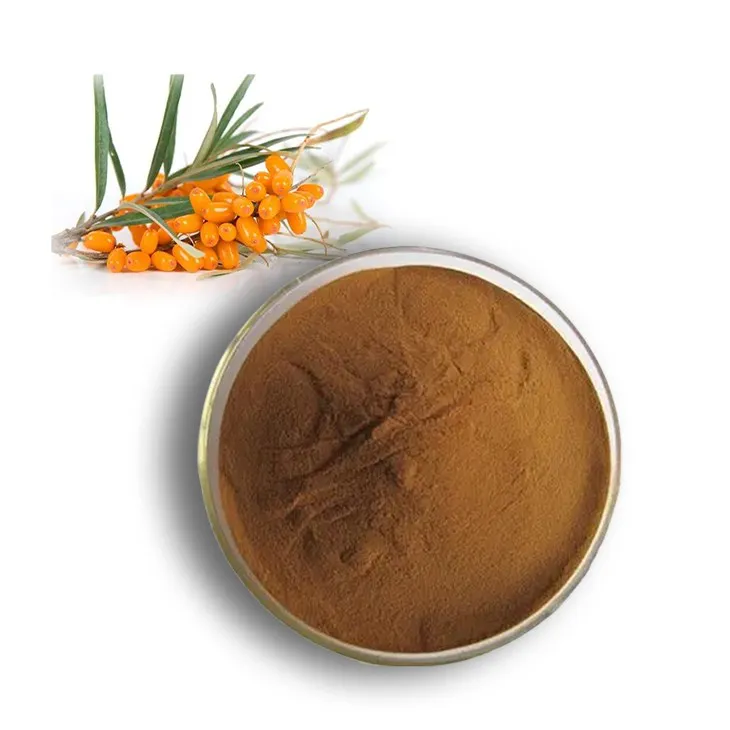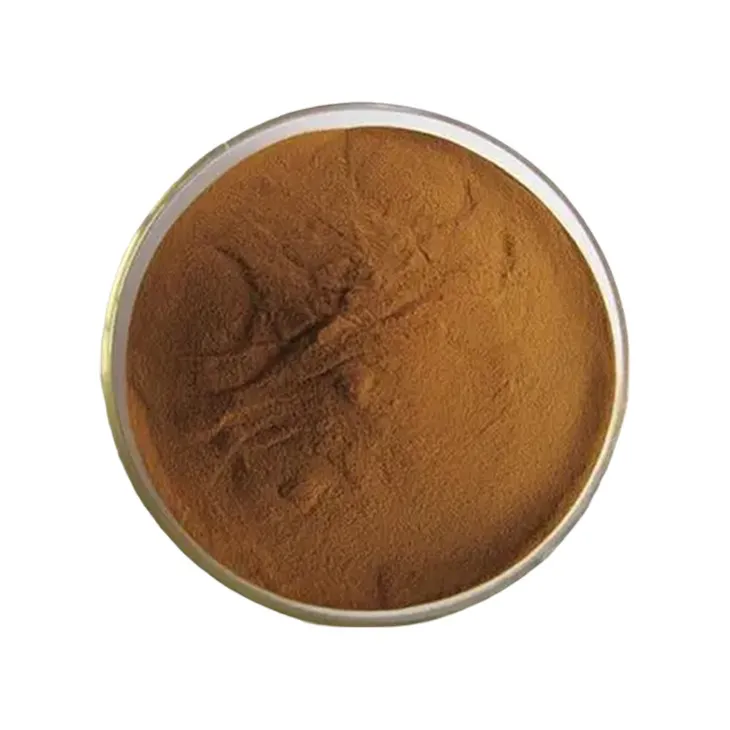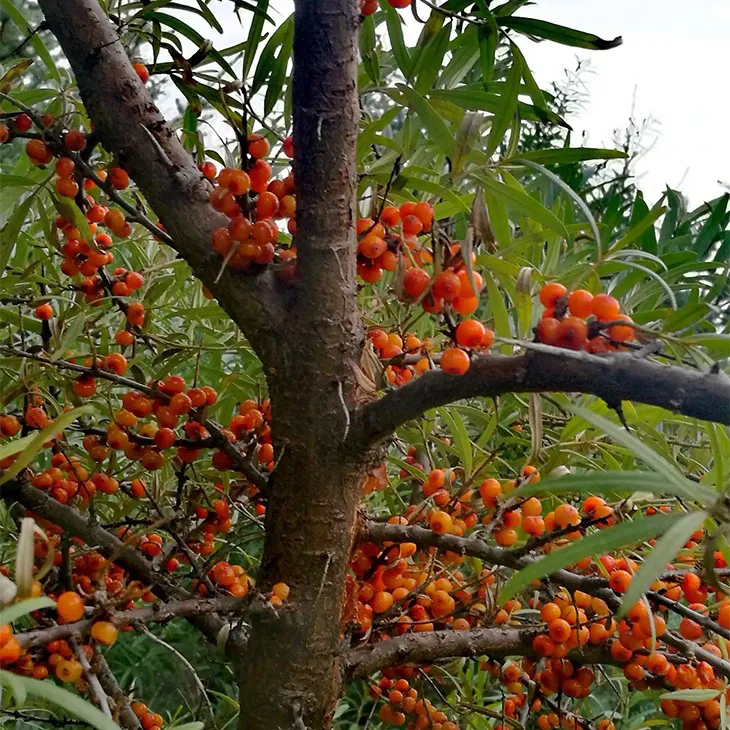- 0086-571-85302990
- sales@greenskybio.com
The process of extracting isorhamnetin from seabuckthorn bark extract.
2024-11-30

1. Introduction
Sea - buckthorn (Hippophae rhamnoides) has long been recognized for its rich composition of bioactive components. Among these, isorhamnetin found in the bark of sea - buckthorn has attracted significant attention. Isorhamnetin is a flavonol with numerous potential health benefits, including antioxidant, anti - inflammatory, and anticancer properties. The extraction of isorhamnetin from sea - buckthorn bark is a crucial step in harnessing these beneficial properties for various applications in the fields of medicine, cosmetics, and food industries. This article will provide an in - depth look at the process of extracting isorhamnetin from sea - buckthorn bark.

2. Sea - Buckthorn Bark: A Source of Isorhamnetin
The bark of sea - buckthorn is a valuable source of isorhamnetin. However, before the extraction process can begin, proper collection and handling of the bark are essential. Sea - buckthorn is typically grown in regions with specific climatic conditions, and the bark is harvested at the appropriate time to ensure maximum isorhamnetin content. Once harvested, the bark needs to be carefully processed to maintain the integrity of the isorhamnetin and other bioactive compounds.

3. Pretreatment of Sea - Buckthorn Bark
3.1 Drying
The first step in the pretreatment of sea - buckthorn bark is drying. Drying helps to reduce the moisture content of the bark, which is important for several reasons. Firstly, it prevents the growth of microorganisms such as bacteria and fungi that could degrade the isorhamnetin. Secondly, it makes the bark more brittle, which is beneficial for the subsequent grinding process. Different drying methods can be used, such as air drying, oven drying, or freeze - drying. Each method has its own advantages and disadvantages, and the choice depends on factors such as cost, time, and the desired quality of the final product.
3.2 Grinding
After drying, the sea - buckthorn bark is ground into a fine powder. Grinding is a crucial step as it significantly increases the surface area of the bark material. This increased surface area allows for more efficient extraction of isorhamnetin during the subsequent extraction process. The grinding can be done using a mortar and pestle for small - scale operations or a mechanical grinder for larger quantities. The particle size of the ground bark should be optimized to ensure good extraction efficiency without causing excessive clogging during extraction.

4. Solvent - Based Extraction
Solvent - based extraction is one of the most common methods for extracting isorhamnetin from sea - buckthorn bark. The choice of solvent is critical as it determines the extraction efficiency and the purity of the final product.
4.1 Selection of Solvents
Several solvents have been tested for their ability to extract isorhamnetin from sea - buckthorn bark. These include ethanol, methanol, ethyl acetate, and water - based solvents. Ethanol is a popular choice due to its relatively high solubility for isorhamnetin, low toxicity, and ease of handling. Methanol also has good extraction capabilities but is more toxic than ethanol. Ethyl acetate is often used for its selectivity in extracting flavonoids. Water - based solvents can be used in combination with other organic solvents or as a part of a more environmentally friendly extraction process. The selection of the solvent also depends on the desired application of the extracted isorhamnetin. For example, if the final product is intended for use in food or cosmetics, a solvent with low toxicity and regulatory approval is preferred.
4.2 Extraction Process
The extraction process typically involves mixing the ground sea - buckthorn bark with the selected solvent in a suitable container. The ratio of bark to solvent, the extraction temperature, and the extraction time are important parameters that need to be optimized. A higher ratio of solvent to bark generally results in better extraction efficiency, but it also increases the cost and the volume of the extract to be processed further. The extraction temperature can range from room temperature to elevated temperatures. Higher temperatures can increase the solubility of isorhamnetin and thus improve extraction efficiency, but they may also lead to the degradation of some bioactive compounds. The extraction time also needs to be carefully controlled. Longer extraction times may lead to higher yields, but they may also introduce impurities or cause degradation of the target compound.
- For example, in a typical ethanol - based extraction, a ratio of 1:10 (bark to ethanol by weight) may be used.
- The extraction may be carried out at a temperature of around 50 - 60°C for 2 - 4 hours.

5. Separation and Purification of Isorhamnetin
Once the extraction is complete, the resulting extract contains not only isorhamnetin but also other components from the sea - buckthorn bark and the solvent. Therefore, separation and purification steps are necessary to obtain pure isorhamnetin.
5.1 Filtration
The first step in the separation process is filtration. Filtration is used to remove the solid particles of the bark from the extract. This can be achieved using a simple filter paper or a more sophisticated filtration system such as a Buchner funnel for larger - scale operations. The filtrate obtained after filtration contains the dissolved isorhamnetin and other soluble components.
5.2 Solvent Evaporation
After filtration, the solvent in the filtrate needs to be removed. This is typically done by evaporation. Solvent evaporation can be carried out under reduced pressure or at normal atmospheric pressure depending on the volatility of the solvent and the desired final product. Reduced - pressure evaporation is often preferred as it can be carried out at lower temperatures, which helps to prevent the degradation of isorhamnetin. Once the solvent is completely evaporated, a crude extract of isorhamnetin is obtained.
5.3 Chromatographic Separation
To further purify the isorhamnetin, chromatographic separation techniques can be used. High - performance liquid chromatography (HPLC) is a commonly used method for separating isorhamnetin from other flavonoids and impurities. In HPLC, the crude extract is injected into a column filled with a stationary phase, and a mobile phase is passed through the column at a controlled flow rate. The different components in the extract interact differently with the stationary and mobile phases, resulting in their separation. Isorhamnetin can be collected as a pure fraction based on its retention time in the column.
6. Characterization of Isorhamnetin
After purification, the isorhamnetin obtained needs to be characterized to confirm its identity and purity. Various analytical techniques can be used for this purpose.
6.1 Spectroscopic Analysis
Spectroscopic techniques such as ultraviolet - visible (UV - Vis) spectroscopy, infrared (IR) spectroscopy, and nuclear magnetic resonance (NMR) spectroscopy are commonly used to characterize isorhamnetin. UV - Vis spectroscopy can provide information about the electronic transitions of isorhamnetin, which can be used to confirm its presence and estimate its concentration. IR spectroscopy can be used to identify the functional groups present in isorhamnetin, while NMR spectroscopy can provide detailed information about the molecular structure of isorhamnetin.
6.2 Mass Spectrometry
Mass spectrometry (MS) is another powerful technique for characterizing isorhamnetin. MS can determine the molecular weight of isorhamnetin and its fragmentation pattern, which can be used to confirm its identity and detect any impurities or related compounds.
7. Applications of Isorhamnetin
The extracted isorhamnetin has a wide range of potential applications due to its beneficial properties.
7.1 Antioxidant Applications
As an antioxidant, isorhamnetin can scavenge free radicals and prevent oxidative damage in biological systems. This makes it a potential ingredient in anti - aging products, both in the cosmetic and nutraceutical industries. It can also be used to preserve food products by preventing lipid peroxidation and other oxidative processes.
7.2 Pharmaceutical Applications
Isorhamnetin has shown potential in various pharmaceutical applications. Its anti - inflammatory properties make it a candidate for the treatment of inflammatory diseases such as arthritis. Additionally, its anticancer properties have been studied, and it may play a role in cancer prevention or as an adjuvant in cancer therapy.
7.3 Food and Beverage Applications
In the food and beverage industry, isorhamnetin can be used as a natural colorant and flavor enhancer. It can also be added to functional foods and beverages to provide health - promoting benefits.
8. Conclusion
The extraction of isorhamnetin from sea - buckthorn bark is a complex but important process. Starting from the proper handling of the bark, through solvent - based extraction, separation, and purification steps, pure isorhamnetin can be obtained. The characterization of isorhamnetin ensures its quality and identity, and its wide range of applications makes it a valuable compound. Continued research in this area is needed to optimize the extraction process, improve the purity of the final product, and explore new applications of isorhamnetin. With the increasing demand for natural products with health - promoting properties, the extraction of isorhamnetin from sea - buckthorn bark holds great potential for the development of novel products in various industries.
FAQ:
What are the main steps in the extraction of isorhamnetin from seabuckthorn bark?
The main steps include proper handling of the seabuckthorn bark such as drying and grinding to increase the surface area. Then, solvent - based extraction is carried out, and different solvents may be tested for efficiency. After obtaining the extract, further separation techniques are applied.
Why is it important to increase the surface area of seabuckthorn bark before extraction?
Increasing the surface area of the seabuckthorn bark before extraction is important because it allows for better interaction between the bark and the solvent. This enhances the extraction efficiency, enabling more isorhamnetin to be extracted from the bark.
What are the common solvents used for isorhamnetin extraction from seabuckthorn bark?
Common solvents include ethanol, methanol, and ethyl acetate. However, different solvents are often tested to determine which one is most efficient for extracting isorhamnetin from seabuckthorn bark.
What are the properties of isorhamnetin?
Isorhamnetin has antioxidant properties and other beneficial properties. These properties make it valuable in various applications, such as in the development of natural products.
Why is the extraction of isorhamnetin from seabuckthorn bark a significant area of study?
The extraction of isorhamnetin from seabuckthorn bark is a significant area of study because isorhamnetin has antioxidant and other beneficial properties. Sea - buckthorn is also known for its various bioactive components, and extracting isorhamnetin from its bark can contribute to the development of natural products.
Related literature
- Isorhamnetin: A Promising Bioactive Compound from Sea - Buckthorn"
- "Optimization of Solvent Extraction for Isorhamnetin from Sea - Buckthorn Bark"
- "The Bioactivity of Isorhamnetin Extracted from Sea - Buckthorn and Its Potential Applications"
- ▶ Hesperidin
- ▶ citrus bioflavonoids
- ▶ plant extract
- ▶ lycopene
- ▶ Diosmin
- ▶ Grape seed extract
- ▶ Sea buckthorn Juice Powder
- ▶ Beetroot powder
- ▶ Hops Extract
- ▶ Artichoke Extract
- ▶ Reishi mushroom extract
- ▶ Astaxanthin
- ▶ Green Tea Extract
- ▶ Curcumin Extract
- ▶ Horse Chestnut Extract
- ▶ Other Problems
- ▶ Boswellia Serrata Extract
- ▶ Resveratrol Extract
- ▶ Marigold Extract
- ▶ Grape Leaf Extract
- ▶ blog3
- ▶ blog4
-
Chinese Cassia Seed Extract Suppliers.
2024-11-30
-
Suppliers of Organic Diosmin Powder.
2024-11-30
-
Hesperidin with the best reviews.
2024-11-30
-
Organic Epimedium Extract Powder Supplier.
2024-11-30
-
The best olive leaf extract in nature.
2024-11-30
-
Cordyceps extract suppliers.
2024-11-30
-
Chinese aguaje extract powder manufacturers.
2024-11-30
-
Lemon Balm Extract
2024-11-30
-
Hawthorn Extract
2024-11-30
-
Acerola Extract
2024-11-30
-
Tongkat Ali Extract
2024-11-30
-
Polygonum Cuspidatum Extract
2024-11-30
-
Oyster Mushroom Extract Powder
2024-11-30
-
Clove Powder
2024-11-30
-
Elderberry Extract
2024-11-30
-
Longan Extract
2024-11-30
-
Coix Seed Extract
2024-11-30





















